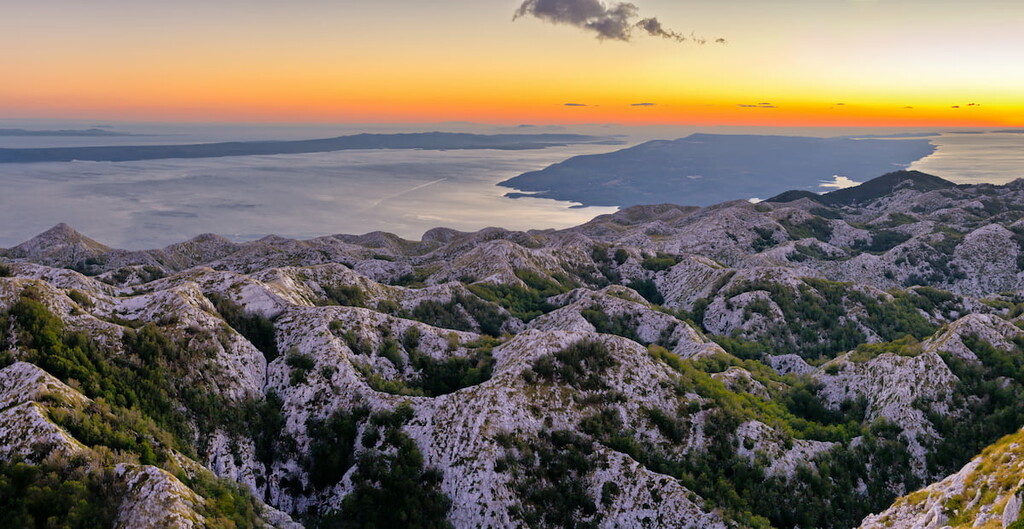Get PeakVisor App
Sign In
Search by GPS coordinates
- Latitude
- ° ' ''
- Longitude
- ° ' ''
- Units of Length

Yes
Cancel
Share ×

Scan the QR code and open PeakVisor on your phone
❤ Wishlist ×
Choose
Delete
Park Prirode Biokovo (Nature Park Biokovo) is a small protected area located in the Dalmatia region of Croatia near the coast of the Adriatic Sea. It protects the Biokovo massif, together with its beautiful rocky peaks, karst formations, and green forests. There are 100 named mountains in Park Prirode Biokovo. The highest and the most prominent mountain in the park is Sveti Jure (1,762 m/ 5,780 ft).
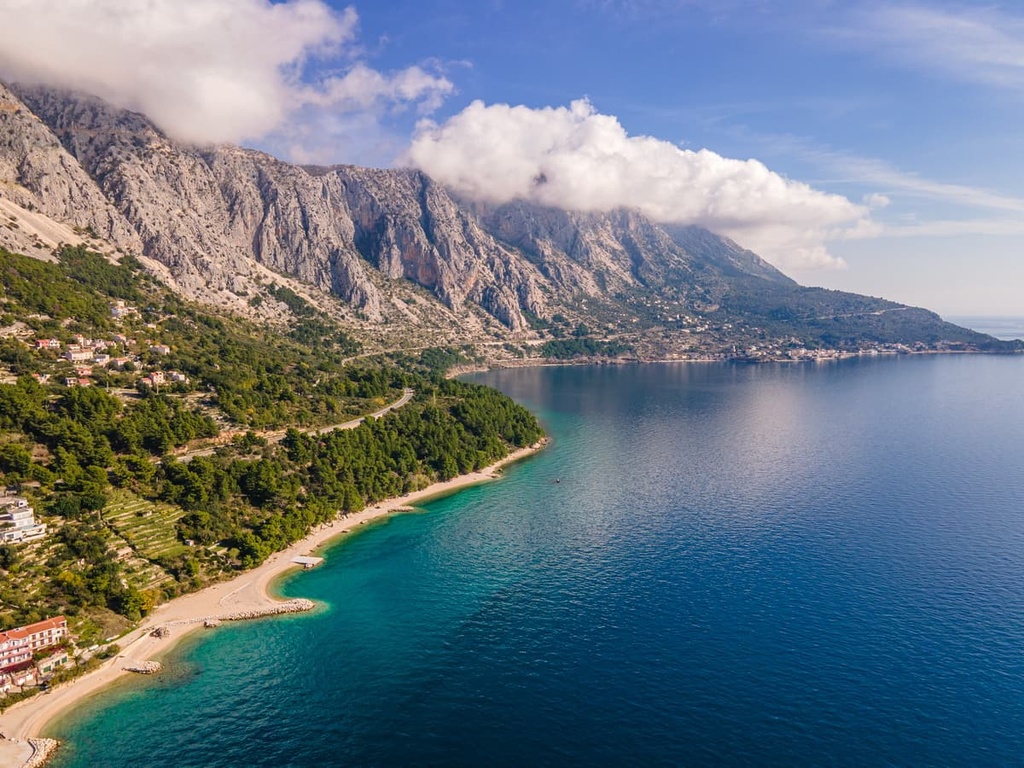
Biokovo Nature Park lies in Dalmatia, a region of Croatia that’s located along the coast of the Adriatic Sea. The park lies between the Adriatic Sea and the border with Bosnia and Herzegovina.
The park is located within numerous Croatian municipalities, including Brela, Baška Voda, Makarska, Tučepi, Podgora, and Zagvozd. The closest small towns near Biokovo Nature Park are Makarska, Split, and Dubrovnik.
The locals call the Biokovo massif a giant with “its roots in the sea and head between lightning bolts.” It really lives up to this name, and Nature Park Biokovo is there to protect this enormous mountain.
The park itself was named a nature reserve in 1981. It has an area of 95.5 sq. km (59 sq. mi) and its borders are the Adriatic Highway road to the east, as well as the villages of Zagvozd, Podgora, and Igrane to the north, south, and west.
Biokovo Nature Park is the only national park in this area, making it unique for the region. The Biokovo Mountain Range is part of the Dinaric Alps. The highest peak is called Sveti Jure (1,762 m/ 5,780 ft).
The Dalmatian region of Croatia includes the country's most popular tourist destinations. It was first mentioned in written texts during the Roman era, and the name derives from the ancient Illyrian tribe of Dalmatae who lived in the area.

The park has a rich biodiversity with many endemic species that are not found anywhere else in Europe. This makes it an important site for tourists interested in nature and biodiversity.
Of course, many hikers come to visit the park as well, due to its beautiful hiking trails, thick forests, and rugged karst landscapes. Locals also speak fondly of Biokovo since it was a source of livelihood for generations.
Biokovo Nature Park contains only one mountain, Biokovo. Biokovo is a long and thin mountain massif that grows vertically from the Makarska Riviera. The mountain is a natural border between the continental and Mediterranean climates. It stretches from northwest to southeast, in line with the rest of the Dinaric Alps.
There are numerous things to see in the park and include:
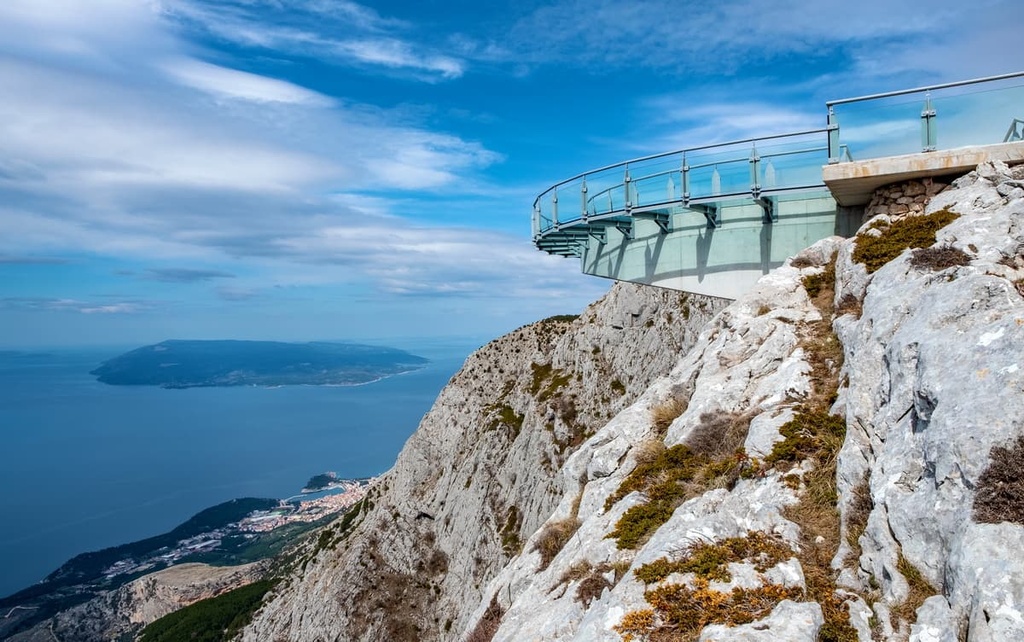
What sets Biokovo apart from other mountain ranges in Croatia and the Dinaric Alps region is its geomorphology and how steeply it ascends from the seaside. The sea-facing side of the mountain reaches up to 300 m (984 ft) in elevation and then becomes very craggy as you reach the summit.
Biokovo, just like the rest of the Dinaric Alps, was formed when the African and European tectonic plates collided. The rocks found in the range formed at the bottom of the ancient Tethys Ocean, alongside the rocks found in much of the rest of the mountain ranges in the southern part of Europe.
We can divide the Biokovo mountain region into the coastal belt, central mountain ridge, and the Biokovo hinterland.
The coastal belt is dominated by Tertiary and Quaternary deposits, meaning that flysch rocks are often found in the coastal area. The central mountain ridge of Biokovo rose during the Mesozoic period, and it mostly consists of limestone rocks. The hinterland, where locals built the village of Zagvozd, is full of flysch sediments and karst fields.
Karstification formed the mountain’s terrain. This process occurs when limestone dissolves in slightly acidic rainwater. The limestone rocks that make up Biokovo consist of calcium carbonate and calcium sulfate. Water slowly dissolves these compounds, creating the caves and other landscape features that we see to this day.

Indeed, on Biokovo, one can see numerous karst formations. You can see them on the mountain tops and in the valleys below. The Biokovo Nature Park is home to numerous karst forms such as ravines, sinkholes, pits, and caves.
The largest caves on Biokovo include Krjava Cave, Mokre Noge (which is currently the fourth-deepest cave in Croatia), and the Amfora Cave. So far, the park boasts at least 177 explored caves and at least 33 caves that have yet to be documented. As a result, there are at least 200 caves in Biokovo Nature Park, which is an enormous amount considering the park's size.
Also, many fossilized remains have been found in these caves and pits, which hint at how ecosystems thrived here in the past. So far, speleologists found remains of chamois, brown bears, and deer inside of these cave systems.
Karst also affects hydrology and the formation of springs in the region. On the contrary to what one might expect, the Biokovo hinterland and peaks are not that scarce with water.
Experts believe this is due to the proximity of the region to the sea. Springs and water sources are most frequent during snowmelt, and while some might dry up during summer, others are present throughout the year.
Still, most farmers on the Biokovo hinterland relied on rainwater for everyday life and cattle raising. The biggest water source inside of the Biokovo Nature Park is Vrulja, which is located between Pisak and Brela.
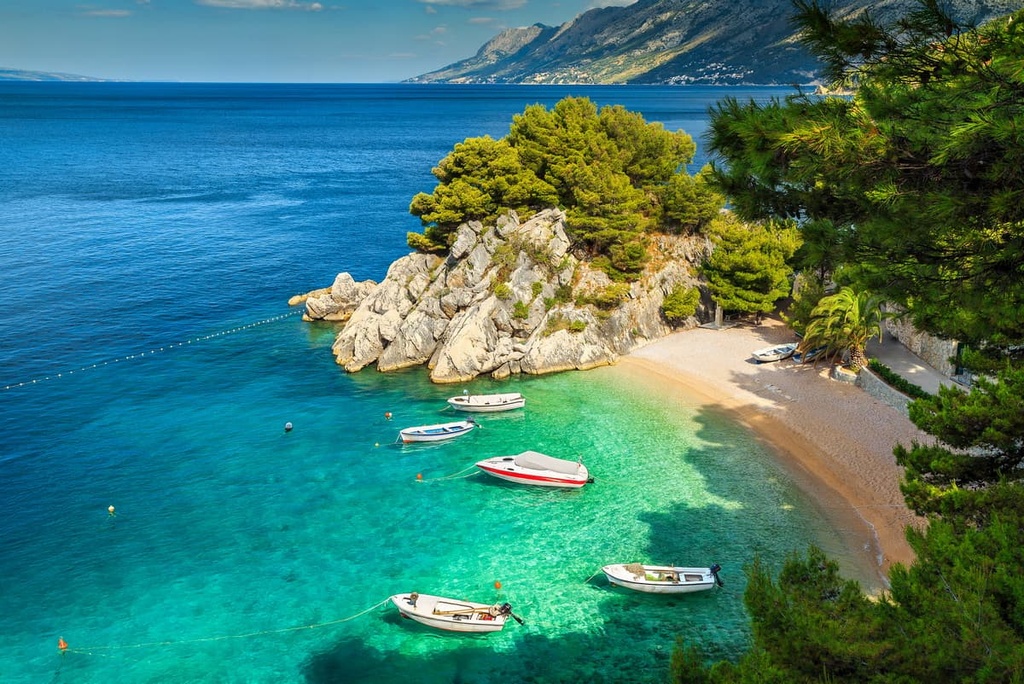
Biokovo is the only mountain inside of the Biokovo Nature Park. Like the rest of the Adriatic Dinarides, Biokovo has a lush forested hinterland and a rocky, almost barren frontal side. It divides the seaside and plains geographically, geologically, climatologically, and culturally.
As we’ve already mentioned, the Biokovo massif truly is a giant. It lies on the Adriatic Coast, and it is 36 km (22 mi) long and 9 km (5.5 mi) wide. The eastern part of Biokovo massif (the hinterland or Zagorje) is a slightly tilted plateau that rises from the sea to an elevation of approximately 300 m (984 ft).
The hinterland of the massif is a fertile and green plateau with numerous karst water sources. On the top of the mountain, you’ll also find a plateau that’s about 4 km (2 mi) wide. This is a developed karst relief that decreases in elevation as you make your way toward the seaside.
Some of the highest peaks inside the Biokovo Nature Park include:
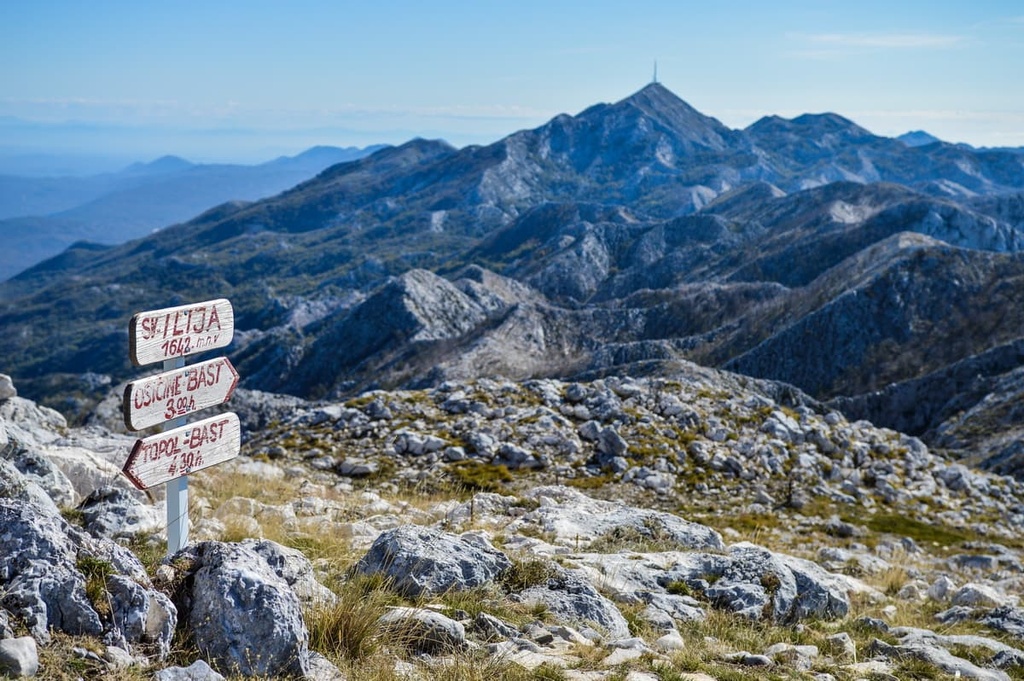
Biokovo Nature Park is one of the most famous Croatian natural parks, and it offers a wide variety of landscapes and habitats for many different species.
The government of Croatia established Biokovo Nature Park as a protected area in 1981 to preserve its natural beauty and biodiversity. Its territory includes forests, karst fields, rock faces, meadows, pastures, springs, and streams.
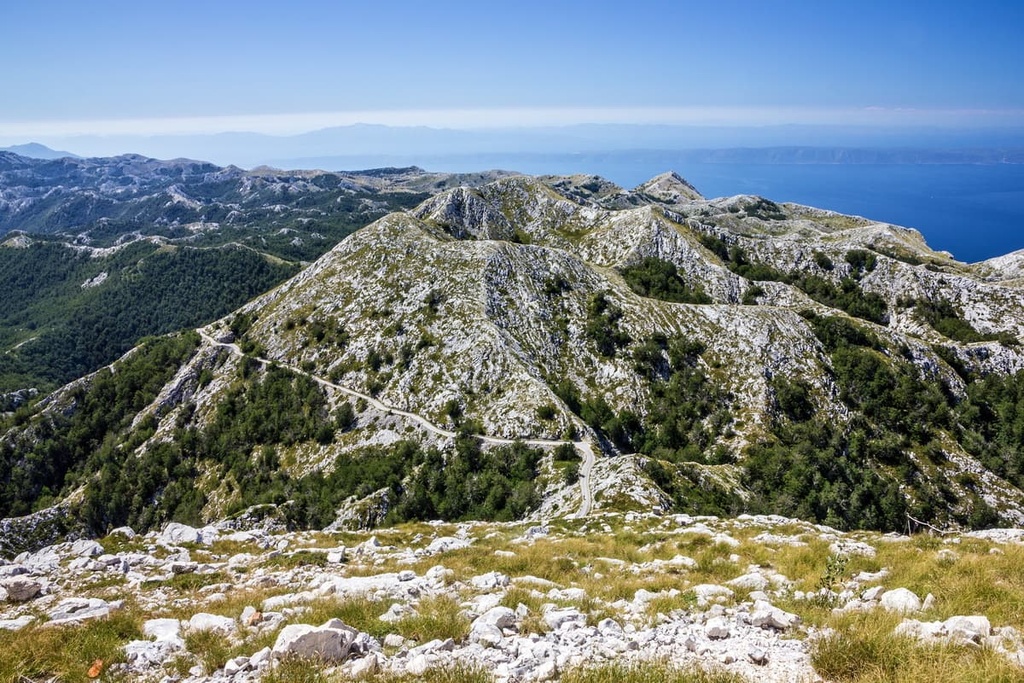
As one would expect, the climate in Biokovo Nature Park is harsh. Even though the summers here are hot and long, the winters are cold and wet. The local climate results from the region’s elevation, exposure, and relief.
Biokovo is where two climate regions—the hinterland continental climate and the Mediterranean climate—meet, and, as a result, there are frequently harsh winds and storms in the area.
Frequent weather changes are common in the region, and this is solely because these two climates constantly battle. The mean annual temperature on the top of Sveti Jure (1,762 m/ 5,780 ft) is 4° C (39° F). Of course, there is a considerable temperature difference between noon and midnight, especially in the hinterland and in valleys below the peaks.
While the summers are sunny, winters can be very harsh. High levels of precipitation are a regular occurrence in the park, and snow is not uncommon on the peaks.
Of course, while the temperatures are high on the seaside, the air is more pleasurable on the mountain. That is why most tourists love to visit the peak of Sveti Jure (1,762 m/ 5,780 ft) during the high season. If you decide to visit the park, make sure to bring a rain jacket with you just in case you get caught up in a thunderstorm.

So far, the park has had over 1,500 different plant species recorded on its premises. The most interesting one is the Biokovo silvery dwarf harebell, which has, so far, only recorded in the mountains of Dalmatia, mostly between 1,400 m (4,593 ft) and 1,700 m (5.577 ft). There are 40 other endangered plant species in the park.
While the massif and its nature park might seem rugged and lifeless, numerous species of animals live here. The local wildlife includes amphibians like the fire salamander and tree frog, as well as 13 different species of bats.
The birdlife in the park includes numerous subspecies of the eagle, many of whom nest in the area due to its large snake population, which includes species like the Balkan whip snake and horned viper. The park’s mammal population is rising, with the most notable species being ibex, hare, wolf, chamois, and wild boars.
The ecosystems found in the park include:

The Kotišina Botanical Garden protects the local plant life. It lies on the seaward slope of Biokovo. Here, one can see 300 wild species of flora. The garden contains only local species, so it showcases the biodiversity of the area.
A local Franciscan monk, dr. Fra Jure Radić, established the Kotišina Botanical Garden. The garden is located between 350 m (1,148 ft) and 500 m (1,640 ft) in elevation, and it is protected by a seventeenth-century fortification.
Kotišina Botanical Garden is 16.5 ha (40 acres) in size, which is a considerate size for a botanical garden in this part of the world. Of course, there are numerous maintained trails here that one can use to explore the garden and enjoy its serenity. Nature lovers will also enjoy the small nearby waterfall and canyon called Proslap, which is located on the opposite side of the mountain.
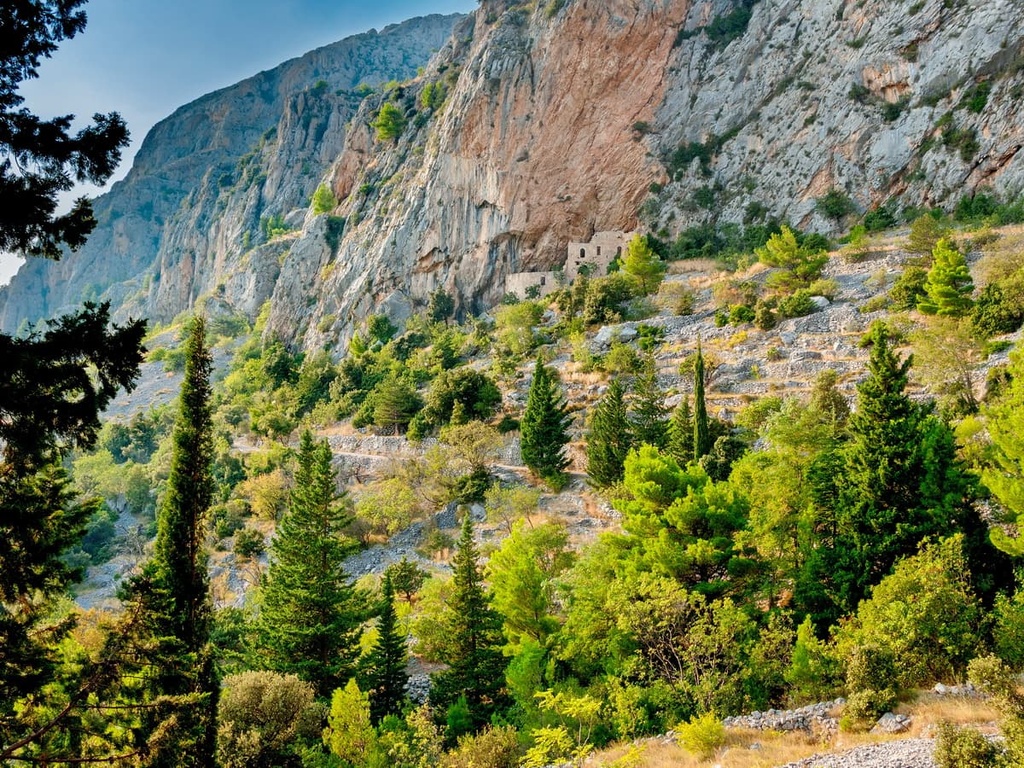
Like many local massifs, Biokovo is considered a border between two regions. These can be climate regions, ecosystems, and two different ways of life.
For locals, the Biokovo massif has long been a giant that stood between them and didn’t allow them access to either the sea or the inland valleys. Of course, Biokovo was still a lifeline to locals for generations since their cattle and families lived off the mountain’s pastures, water, and forests.
Biokovo has four names. The first recorded name of the massif was Adrion, which means “The mountain of the Adriatic Sea.” That’s what the Greeks called Biokovo and it suggests that they believed that its roots are deep in the sea. Of course, even they noticed how close the mountain was to the seaside and how steeply its slopes rose to the peak itself.
The second name of Biokovo that we know is Mons Slavorum, which translates literally to ‘Mountain of the Slavs.’ The Romans believed that Slavic tribes lived here and therefore named it after them.
The locals gave the last two names to Biokovo mountain. The seaside communities called the mountain Bjakovo, and the locals on the continental side called it Biokovo. We believe the name comes from words in the local dialect for ‘white.’ But we don’t know if this white color refers to white snowy hilltops or steep rock faces of the region.
The first people that inhabited the mountain were Illyrians, of the Delmati tribe. These are the same peoples who gave the whole region of Dalmatia its name. They lived in the lower plains of the region and were mostly cattle farmers..
Soon came the Delmati’s feared enemies, the Romans. They wanted to take over their land, but the Delmati would not give it away without a fight. The Romans won and named the whole region of their empire, Dalmatia, which is what the region is known as to this day.
The only major remnant we have of this time period is a collection of burial grounds. Local tribes like the Delmati buried their dead under stone hills called tumuli. Additionally, the Delmati buried their dead with metal offerings to keep with them in their afterlife. One tumuli site is located in Biokovo Nature Park in Gornja Brela.

During the medieval period, local Slavic peoples constructed a church on top of Biokovo. This was a church of st. Jure, a Croatian saint, and it is probably where the name of Sveti Jure (1,762 m/ 5,780 ft) came from. They deconstructed this church and built a TV transmitter in its place in 1965. There is still a small church on top of the mountain where the locals moved it after constructing the TV transmitters.
When the Slavic peoples moved to the area, they built numerous churches and chapels on almost all the peaks of Biokovo. Many of these peaks, such as Sveti Ilija (1,642 m/5,387 ft), which features a chapel to St. Ilias at its summit, were named after these churches.
Like most Croatian mountains, locals also used this one for cattle herding. People built houses and stables in the fields below the peak and used them as pastures and arable land. Today, these houses, which were built in the traditional style of Dalmatinska Zagora, are the only relics of this former way of life.
The first recorded hikes to the tops of Biokovo were made by pilgrims on the lookout for a blessing from St. Jure and St. Ilias. Many centuries later, the local government wanted to protect this area and its way of life. In 1981, the Croatian government proclaimed the area a nature park.
The park has operated since 1989, and it receives about 50,000 visitors each year. Most of them try to climb the Sveti Jure via Biokovo Road. The construction of this road actually started at the end of the nineteenth century and it finished in 1964 with the construction of the TV transmitter at the summit.
The park got an asphalted and maintained road in 1978, which one can use to reach the Biokovo Skywalk. The road takes you from the entrance of Biokovo Nature Park at 360 m (1,181 ft) to Sveti Jure.

As one of the most popular tourist destinations in Dalmatia and Croatia, Biokovo Nature Park is full of excellent hiking trails. Here, you will find a trail that works for just about anyone. Just make sure that you have the proper hiking equipment ready for your adventure.
Here are some of the trails we recommend when visiting Biokovo Nature Park:
The most popular tourist destination in the Biokovo Nature Park is Sveti Jure because it is the highest peak of the Biokovo massif. One can reach it via the Biokovo Road by car or by bike. The road is steep and narrow, so if you have doubts about your driving skills, you should not try to make the journey on your own.
The more interesting adventure is to hike to the top of Biokovo. There are numerous hiking trails, paved and unpaved, that lead to the summit. The most popular ones depart from the villages of Veliko Brdo or Vroplje, and they take you to the top of Sveti Jure.
Both trails go from lush deep forests full of wildlife to barren rocky and steep trails. This is an expert hiking trail that’s perfect for experienced hikers that know what they are doing. With 450 m (1,476 ft) of elevation gain and a length of 11 km (6 mi), this trail is not for the faint of heart.
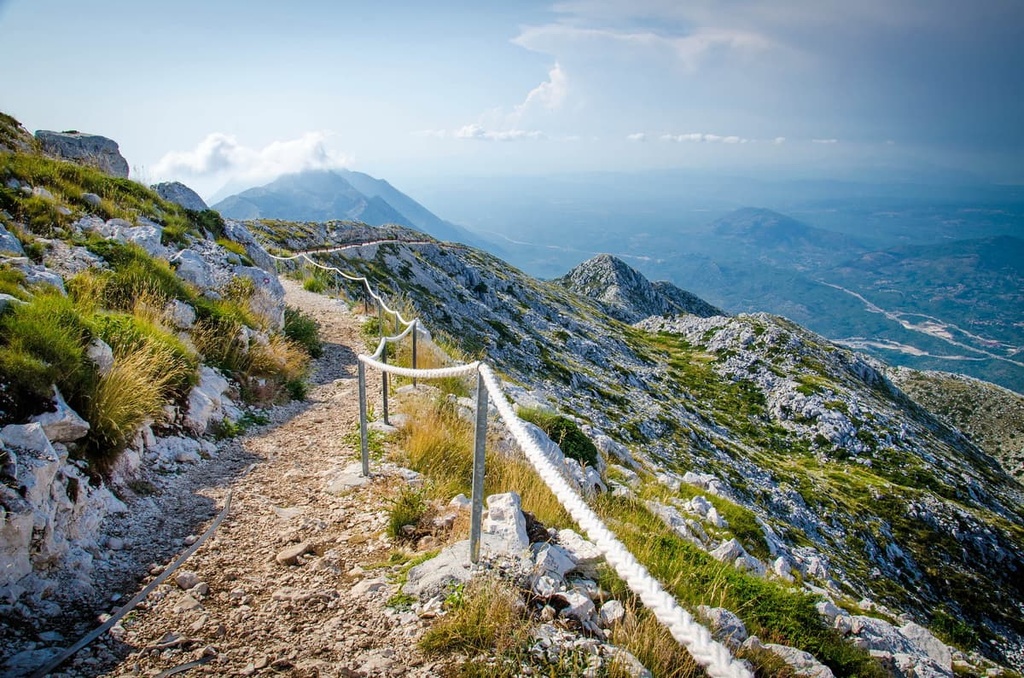
The second most popular hiking trail in Biokovo Nature Park takes hikers to the third highest peak of Biokovo, Sveti Ilija (1,642 m/5,387 ft). The trailhead is located in Gornja Brela, where the 11 km (6 mi) hike begins. The trail takes most hikers 4 hours to complete, and it is an intermediate-level hiking adventure.
Like most peaks in the Dinaric Alps, Biokovo requires a good level of fitness from its hikers due to its steep and sometimes long ascents. However, it’s still a nice option for intermediate hikers because it’s a well-maintained trail.
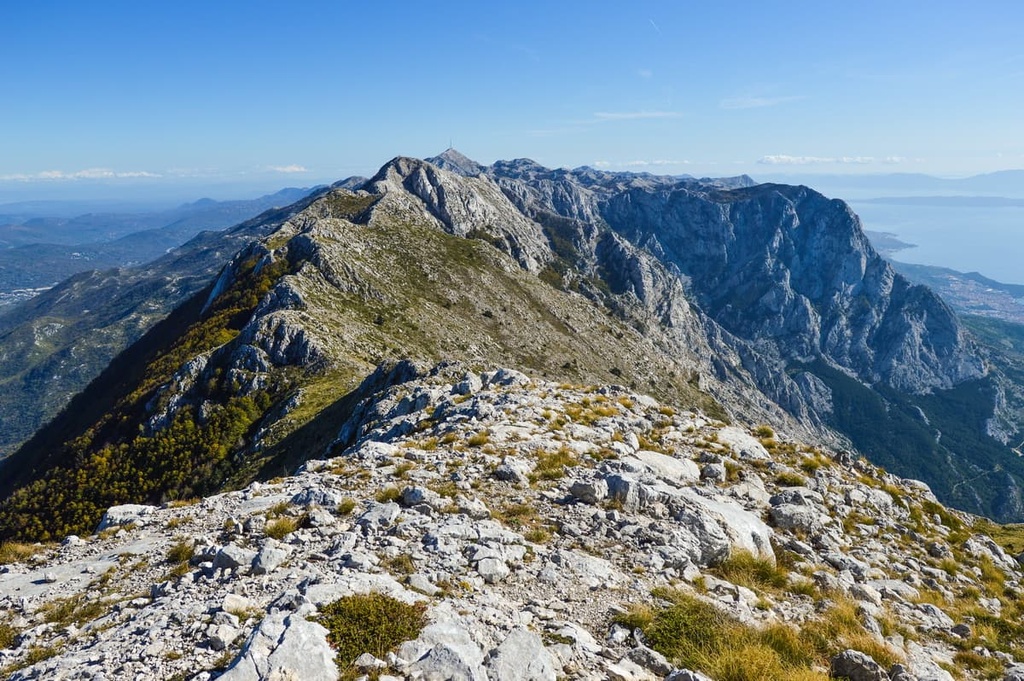
Another easy and accessible path that tourists can enjoy in Biokovo Nature Park, is the trail to Nevisina Stina lookout. The lookout's name, when translated, means ‘Bride’s Rock.’ Here one can see rocks in the shape of a horse, bride and groom, and their wedding party.
According to a local legend, the bride’s mother cursed her for marrying someone who lived far away from her and told her that she would turn to rock once she saw the sea. Once the bride and groom passed over the summit of Biokovo to the seaside, both them, their wedding party, and horses all turned to stone.
One can reach these mythical rocks by following the trail from Gornja Brela for 8 km (5 mi). This is an easy to intermediate-level hike. The trail is paved or maintained for most of the route.
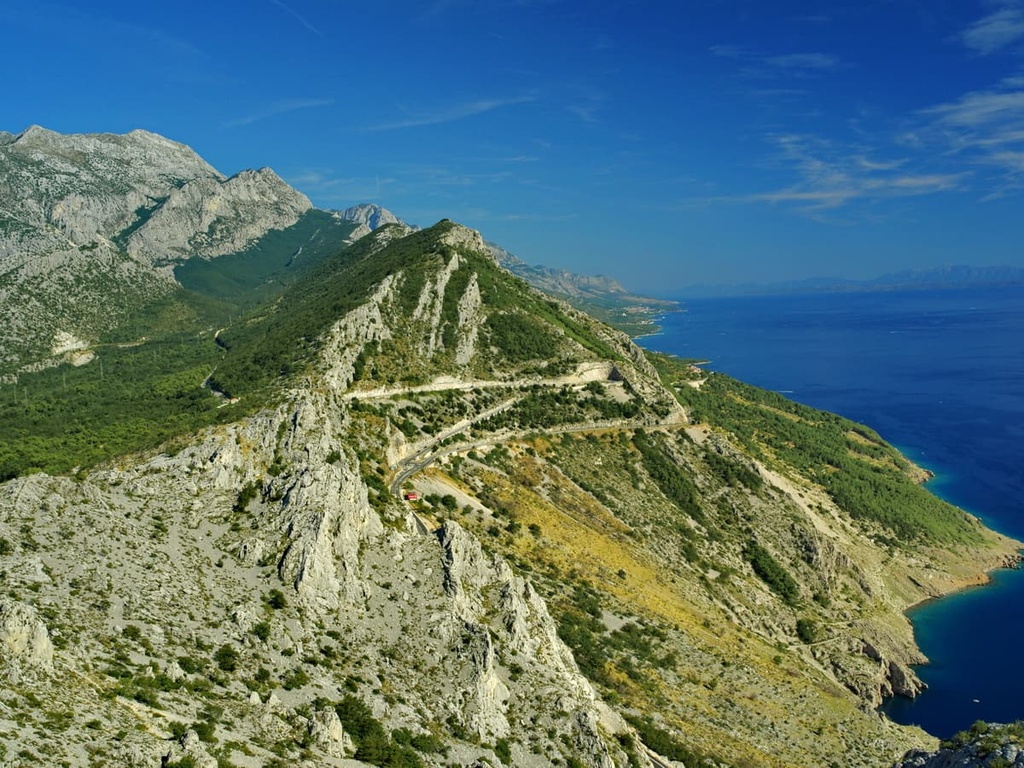
One can reach Biokovo Nature Park via Split or Dubrovnik or by crossing the border from Bosnia and Herzegovina. You’ll also enter the park by traveling through the city of Makarska . After turning to the village of Vrgorac, you will find an entrance to the park.
Here are some of the cities you can check out during your visit to Biokovo Nature Park:
Split is the second-largest city in Croatia and the largest city in Dalmatia. It is also one of the most important cultural and economic centers in the country. Split was founded by Roman Emperor Diocletian in the year 305 as an administrative center for the Roman Empire.
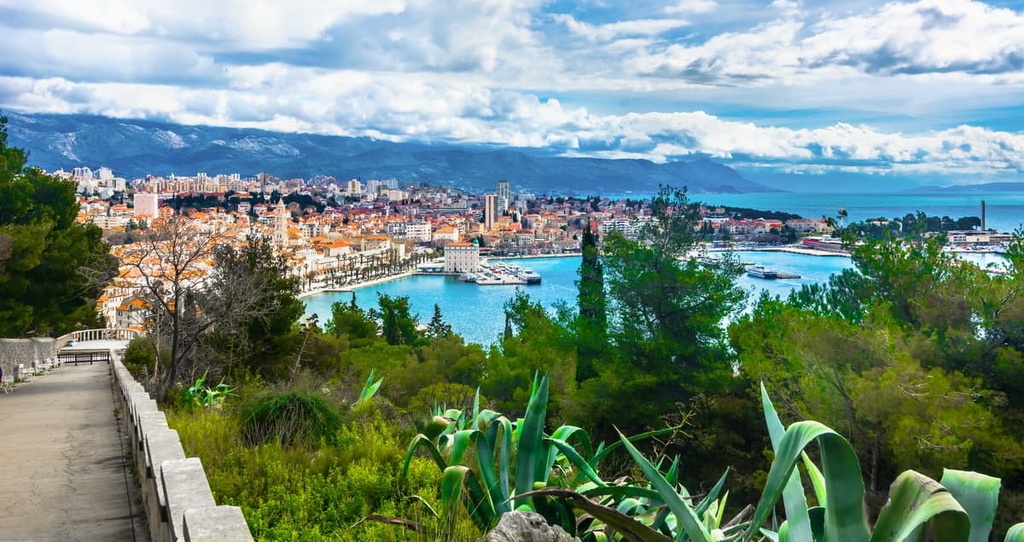
When visiting the city, one can still see remains of the Roman town and take a guided or museum tour through it. As this is a famous tourist destination, Split can offer any kind of accommodation you can ask for from a campsite to a five-star hotel. You can reach Split via air, rail, road, and water.
Makarska is a coastal city in Dalmatia. It is home to around 25,000 people, and it lies on the coast of the Adriatic Sea. The city has been inhabited since ancient times and was first mentioned in documents dating back to the medieval period.
Makarska is the closest city to Biokovo Nature Park, making it a top-rated tourist destination. You can reach Makarska by rail, road, and water. Since the city is very popular with tourists, you are sure to find almost any kind of accommodation you can imagine in Makarska during your stay.
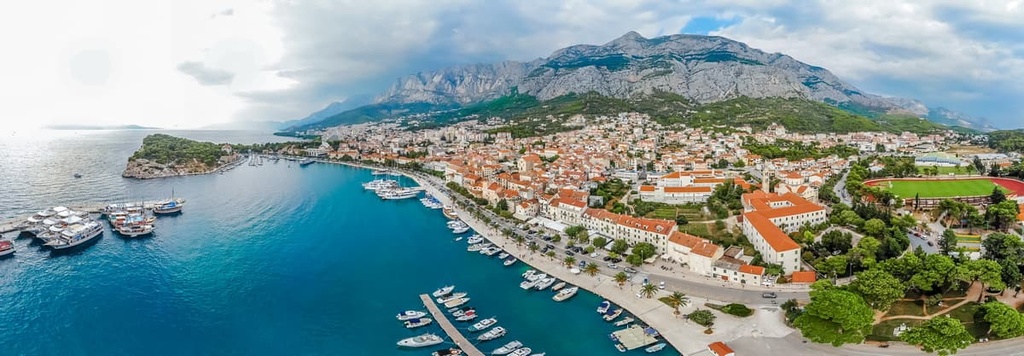
Dubrovnik is a city in Croatia that’s located on the Adriatic Sea. It is one of the most popular tourist destinations in Europe and has been continuously inhabited since Roman times. The city of Dubrovnik is a beautiful place that has been attracting tourists for centuries.
The old town was declared a UNESCO World Heritage Site in 1979. Dubrovnik’s history also includes an invasion by Napoleon.
Since Dubrovnik is so popular, it’s best to reserve your hotels or B&Bs ahead of time, especially if you’re visiting during the summer months. One can reach the city through air, rail, road, and water.
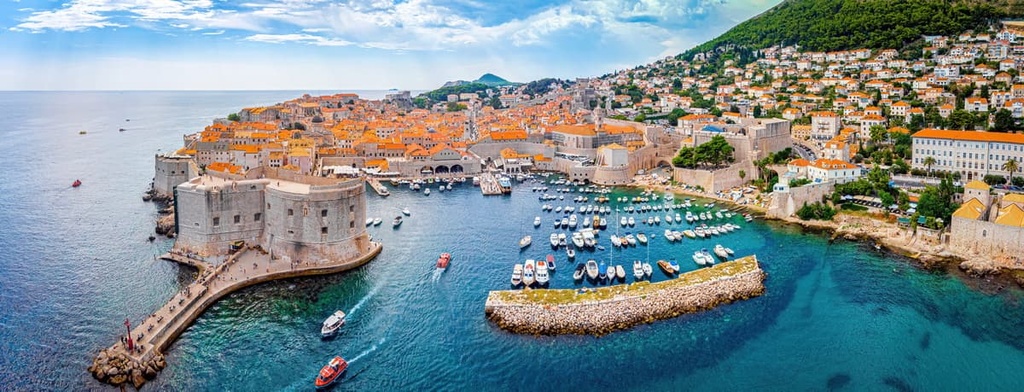
Explore Park prirode Biokovo with the PeakVisor 3D Map and identify its summits.

